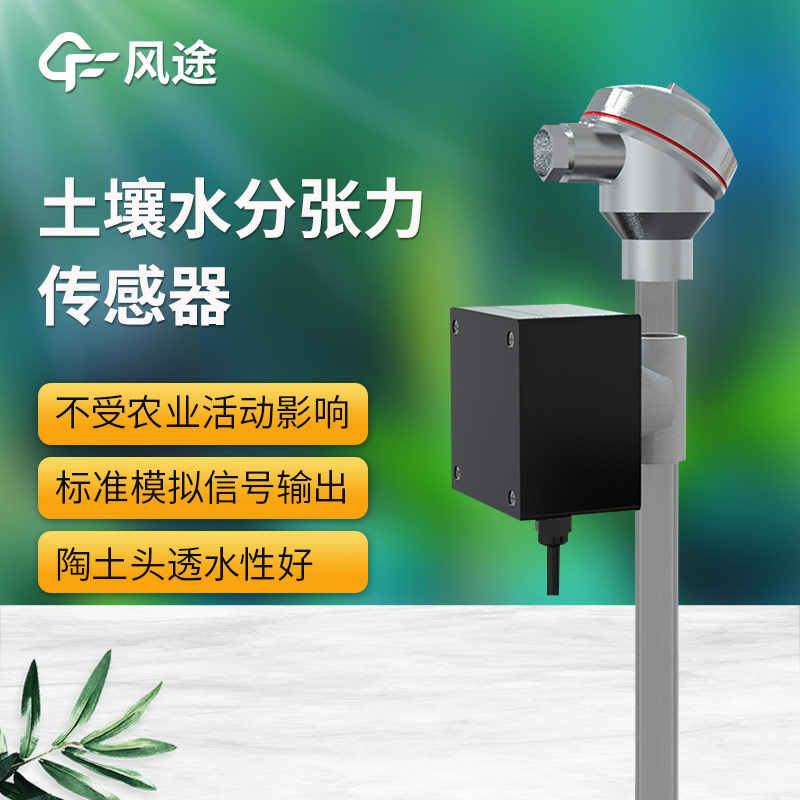Shandong Fengtu IOT Technology Co., Ltd
Sales Manager:Ms. Emily Wang
Cel,Whatsapp,Wechat:+86 15898932201
Email:info@fengtutec.com
Add:No. 155 Optoelectronic Industry Accelerator, Gaoxin District, Weifang, Shandong, China

Sales Manager:Ms. Emily Wang
Cel,Whatsapp,Wechat:+86 15898932201
Email:info@fengtutec.com
Add:No. 155 Optoelectronic Industry Accelerator, Gaoxin District, Weifang, Shandong, China
time:2024-05-28 08:39:35 source:Weather Station viewed:579 time
Today we introduce a soil sensor - water potential sensor.
The concept of soil water potential:
The total soil water potential consists of four elements: gravity, pressure, matrix and infiltration. In unsaturated soils, the soil matrix potential is particularly important and reflects the suction and capillary action of the soil matrix. Matrix potential is expressed in kilopascals or centimetres of water column and has a negative value, as opposed to soil suction. Soil tensiometers are commonly used as measuring tools, but the range and automation of the measurements are limited. So then came the soil water potential sensor.
It uses a transparent PVC pipe for easy observation of water volume and easy replenishment. Equipped with a -100 to 0Kpa vacuum gauge for easy reading. It is suitable for monitoring soil moisture and drought conditions, especially in agricultural cultivation to help determine whether crops need irrigation. When the PVC pipe is filled with water and inserted into the soil, the soil will absorb some of the water, resulting in negative pressure inside the pipe. The greater the negative pressure value, the greater the ability of the soil to absorb water, meaning the drier the soil.
How to install?
1. Prepare cool boiled water by boiling tap water for 20 minutes, cool it down and set it aside.
2. Fill the clay head with cool boiled water and stand it upright for 10 to 40 minutes, uncovered, until the water drips off the surface. Seal with a silicone plug and blot dry with paper towel to reduce tension to about -40 kPa. Observe bubbles rising and shake to exhaust, repeat 2 to 3 times.
3. Immerse the clay head in water, wait until the tension drops to below -10kPa, fill with water again, seal the plug, tighten the end cap, and then standby.
Precautions?
The clay head should avoid oil pollution, in order to prevent microporous blockage leading to instrument failure. The measuring range of the instrument is from -100 to 0Kpa, beyond this range, the clay head may be cracked and leakage. The instrument should be checked and replenished with cooled water regularly, about once every half a month to once a month, taking care not to loosen the sensor. The outdoor instrument should be recovered before winter to prevent freezing and cracking.
Judgement standard?
-10 to 0Kpa means too humid
-30 to -10Kpa is suitable for most crops.
-50 to -30Kpa need to irrigate moisture-loving crops.
Below -50Kpa, most crops need to be irrigated.

level liquid sensor can accurately measure the amount of liquid in a tank and is an important sensor for measuring and monitoring the level in storage tanks, containers and other containers....
In the current context where water resource protection is becoming increasingly important, the Online Multi - parameter Water Quality Analyzer is widely used in water quality monitoring work due to its two major advantages of "online rapid detection" and "low cost".Traditional wa...
In the Internet era, soil moisture monitoring systems can be revitalized by combining with technologies such as the Internet of Things, big data and artificial intelligence. For example, real-time monitoring and remote transmission of soil moisture data can be realized by using IoT technology. By de...
The wetland park mini weather station is an important facility in the construction and management of the wetland park, which provides meteorological data and conducts analysis and research. It adopts wireless transmission technology, through the collection, storage and processing of data, realizing...